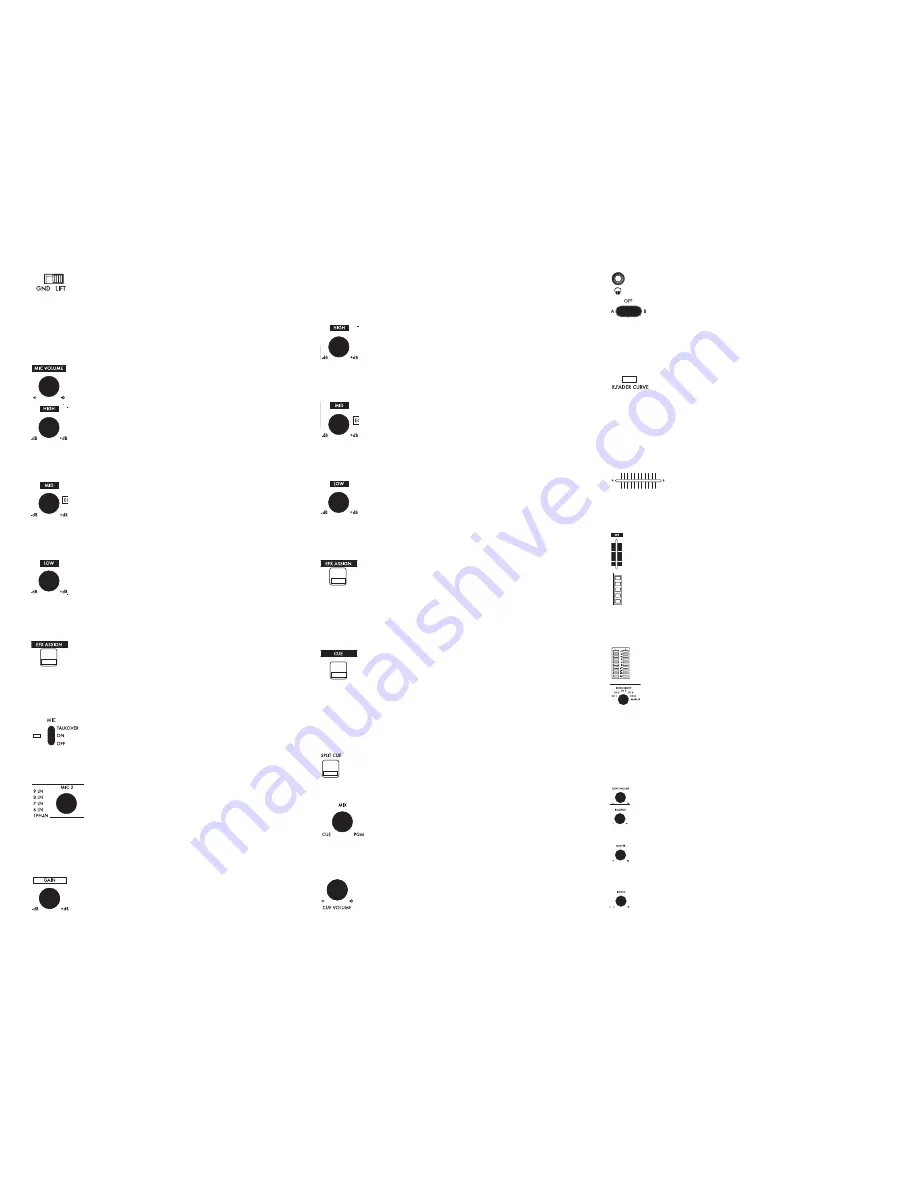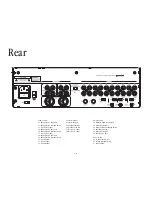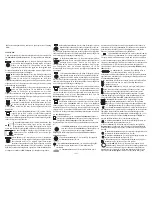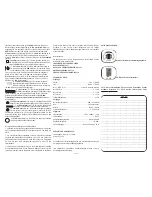
15.
G
ROUND
L
IFT
S
WITCH
(56): This switch lifts the signal ground,
and may help in the event of a stubborn ground loop issue.
Using the
G
ROUND
L
IFT
S
WITCH
is in no way a substitute for proper wiring,
but in a live scenario, it can help to eliminate ground hum. Before chang-
ing the position of the switch, make sure to turn the unit
Off.
If both ‘
GND
’
and ‘
LIFT
’ settings sound identical, then keep the switch set to ‘
GND
’.
FUNCTIONS:
1.
M
IC
V
OLUME
(2): This rotary control alters the volume of the
Microphone that is plugged into the
XLR-1/4” C
OMBO
M
IC
1 I
NPUT
(1).
2.
M
IC
1 H
IGH
B
AND
EQ
(3): This rotary control alters the amount
of high frequency that is applied to Microphone #1. Turning the
control clockwise increases the high frequencies, while turning
the control counterclockwise decreases. In the middle position (the rotary
control is detented here), there is no change being made to the audio sig-
nal.
3.
M
IC
1 M
ID
B
AND
EQ
(4): This rotary control alters the amount
of midrange frequency that is applied to Microphone #1.
Turning the control clockwise increases the midrange frequen-
cies, while turning the control counterclockwise decreases. In the middle
position (the rotary control is detented here), there is no change being
made to the audio signal.
4.
M
IC
1 L
OW
B
AND
EQ
(5): This rotary control alters the amount
of low frequency that is applied to Microphone #1. Turning the
control clockwise increases the low frequencies, while turning
the control counterclockwise decreases. In the middle position (the rotary
control is detented here), there is no change being made to the audio sig-
nal.
5.
M
IC
1 EFX A
SSIGN
B
UTTON
(6): This button assigns the audio
signal of Microphone #1 to the DSP EFX section found on this
mixer. When the LED on this button is illuminated, it indicates
that the signal is being fed through the DSP. When the LED on this button
is extinguished, it indicates that the signal is being output as-is, without any
effect.
6.
M
IC
1 O
N
/O
FF
/T
ALKOVER
S
WITCH
(7): This switch determines
whether Microphone #1 will be on, off, or on with Talkover.
When talkover is engaged, the level of the audio (except for
the microphone) will be attenuated so that the microphone can be easily
heard over any music that may be playing.
7.
D
EVICE
/C
HANNEL
A
SSIGN
K
NOB
(8): This control, which is
found on each mixer channel, determines which set of jacks
will be used to drive that channel. Printed next to the knob
itself is a diagram showing the positions and available devices that can be
assigned to the channel. This feature allows many devices to be connected,
5 of which can be used simultaneously when they are selected using the
D
EVICE
/C
HANNEL
A
SSIGN
K
NOB
s.
8.
C
HANNEL
G
AIN
C
ONTROL
(9): These controls, found on each
mixer channel, allow you to increase or decrease the volume of
each channel. This is useful for matching levels during mixing,
or to make additional signal boosts when the
C
HANNEL
V
OLUME
F
ADERS
(22)
do not provide enough. To match levels while mixing, visually match the
level of the
C
HANNEL
LED VU M
ETERS
(23), by making adjustments to the
C
HANNEL
G
AIN
C
ONTROLS
.
9.
C
HANNEL
H
IGH
B
AND
EQ
(10): This rotary control, found on
each channel, alters the amount of high frequency that is applied
to the corresponding channel. Turning the control clockwise
increases the high frequencies, while turning the control counterclockwise
decreases. In the middle position (the rotary control is detented here),
there is no change being made to the audio signal.
10.
C
HANNEL
M
ID
B
AND
EQ
(11): This rotary control, found on
each channel, alters the amount of midrange frequency that is
applied to the corresponding channel. Turning the control
clockwise increases the midrange frequencies, while turning the control
counterclockwise decreases. In the middle position (the rotary control is
detented here), there is no change being made to the audio signal.
11.
C
HANNEL
L
OW
B
AND
EQ
(12): This rotary control, found on
each channel, alters the amount of low frequency that is applied
to the corresponding channel. Turning the control clockwise
increases the low frequencies, while turning the control counterclockwise
decreases. In the middle position (the rotary control is detented here),
there is no change being made to the audio signal.
12.
C
HANNEL
EFX A
SSIGN
B
UTTON
(13): When these buttons,
found on each channel, are pressed, the audio which corre-
sponds to that channel is routed to the DSP effects section. When
a
C
HANNEL
EFX A
SSIGN
B
UTTON
is active, the LED inside of the button will
illuminate. Only one channel at a time can be assigned to the DSP effects.
When there is no
C
HANNEL
EFX A
SSIGN
B
UTTON
active, the
Master
bus will
be sent through the DSP effects section.
13.
C
HANNEL
CUE S
ELECTOR
(14): These buttons, found on each
channel, route the pre-fader audio signal to the
Cue Section
,
which can be monitored through headphones. This is useful for
playing a particular piece of music through the headphones while there is
another music program playing through the speakers. When a
C
HANNEL
CUE S
ELECTOR
B
UTTON
is active, the LED inside of the button will illumi-
nate. You may choose as many channels as you wish, simultaneously, to be
monitored through the
Cue Section.
14.
S
PLIT
C
UE
B
UTTON
(15): The
Split Cue
function allows you to
monitor sound from the
Cue Section
in one ear, while listening to
the
Program
(Master Bus) in the other ear. This is particularly use-
ful if there is no booth monitor available, or if the monitor is unusable.
15.
CUE/PGM R
OTARY
C
ONTROL
(16): When this rotary control
is all the way to the left, only the
Cue Section
will be heard
through the headphones. When this rotary control is all the
way to the right, only the
Program
(Master Bus) will be heard through
the headphones. When this control is in the middle, an equal mix of
Cue
and
PGM.
16.
C
UE
V
OLUME
C
ONTROL
(17): This controls the volume of the
H
EADPHONE
O
UTPUT
(18).
17.
H
EADPHONE
O
UTPUT
(18)
:
This jack accepts a standard 1/4”
(6.35mm) connector, and will power virtually any headphones.
18.
X-F
ADER
A
SSIGN
S
WTICH
(19): These switches, which are
found on each channel, are used to assign each respective
audio channel to either the left side (A) or the right side (B) of the
X-
F
ADER
(21). When the switch is in the middle position (
Off )
, the audio of
each channel will be controlled solely by the
C
HANNEL
V
OLUME
F
ADER
(22),
and not by the
X-F
ADER
(21).
19.
X-F
ADER
C
URVE
S
WITCH
(20): This switch determines the
taper of the
X-F
ADER
(21). When the switch is set to the left
(gradual taper), the
X-F
ADER
(21) will have a smooth and gradual
response which is best suited towards mixing. When the switch is set to
the right (short taper), the
X-F
ADER
(21) will have a sharper response
which is best suited towards scratch and battle use. For an even sharper
response, replace the stock fader with an
RG-45PRO Scratch Fader
(sold
separately).
20.
X-F
ADER
(21): With this control, you can fade between
all of the active channels that are assigned to the ‘
A
’ side
of the
X-F
ADER
and the active channels that are assigned to the ‘
B
’ side of
the
X-F
ADER
. Assigning channels to the
X-F
ADER
is accomplished using the
X-F
ADER
A
SSIGN
S
WTICHES
(19).
21.
C
HANNEL
V
OLUME
F
ADER
(22): These controls, found on each chan-
nel, allow you to control the amount of signal that is sent to the out-
put of the mixer.
23.
C
HANNEL
LED VU M
ETER
(23): This VU meter displays the prefader
level of the audio source. This has a multitude of uses, such as visually
verifying which channels are receiving audio signal or matching the
volume levels between two sources. For optimal sound, you should adjust
the
C
HANNEL
G
AIN
C
ONTROLS
(9) until the
C
HANNEL
LED VU M
ETER
begins
to light the first blue
LED
.
24.
M
ASTER
LED VU M
ETER
(24): This VU meter displays the level of
the signal being output through the
M
ASTER
O
UTPUTS
of the mixer.
For optimal sound, this should not 5dB on the meter.
25.
Z
ONE
S
ELECT
C
ONTROL
(25): By using this control, you can
select a source to be output directly to the
Z
ONE
RCA O
UTPUTS
(64) found on the rear panel of the mixer. The audio signal output will be
completely prefader, which means that the
C
HANNEL
V
OLUME
F
ADER
(22)
has no effect on the level of the output. However, the audio will still be
affected by the
C
HANNEL
G
AIN
C
ONTROL
(9) and
C
HANNEL
EQ
S
(10, 11, 12).
When the
Z
ONE
S
ELECT
C
ONTROL
is set to
Master
, the
Z
ONE
RCA O
UTPUTS
(64) will behave the same as the
B
OOTH
RCA O
UTPUTS
(63).
26.
Z
ONE
V
OLUME
(26): This rotary control determines the volume of
the audio being sent out through the
Z
ONE
RCA O
UTPUTS
(64).
27.
B
ALANCE
C
ONTROL
(29): This control allows you to pan the
Master
signal from Left to Right. By default, this control should be
in the middle position, which is an equal balance of left and right chan-
nels.
28.
M
ASTER
V
OLUME
C
ONTROL
(30): This rotary control determines
the volume of the audio being sent out through the
M
ASTER
O
UTPUTS
(59,
60).
29.
B
OOTH
V
OLUME
C
ONTROL
(31): This rotary control determines the
volume of the audio being sent out through the
B
OOTH
RCA
<6>





















